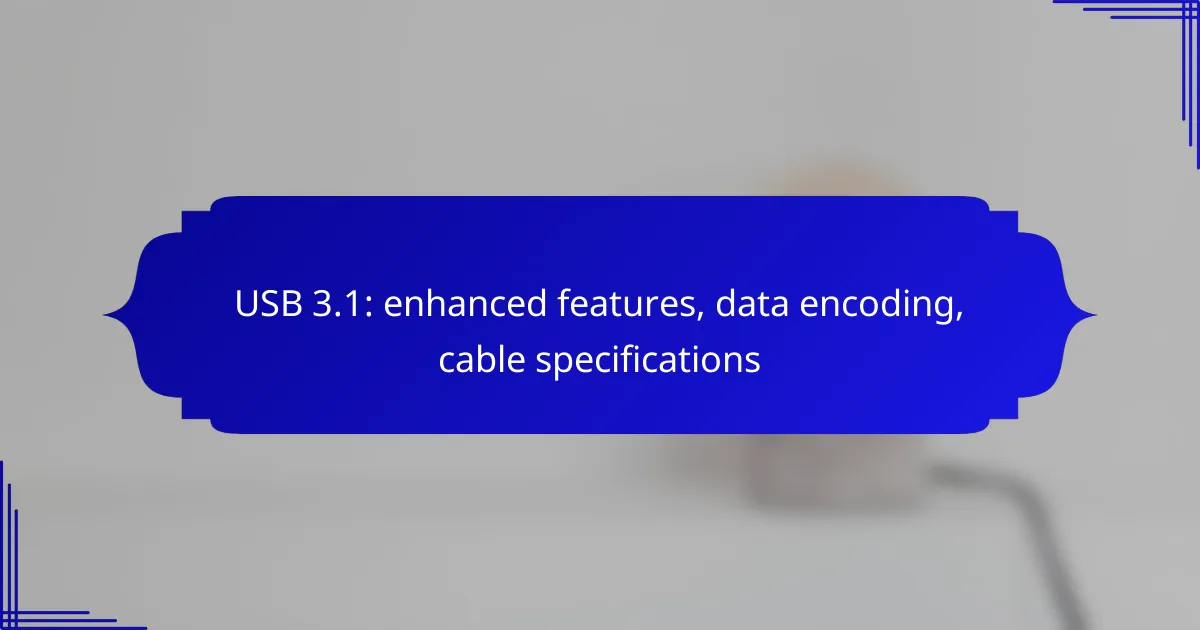USB 3.1 brings enhanced features that elevate data transfer speeds, power delivery, and overall device performance. With its support for the Type-C connector and improved cable specifications, USB 3.1 is designed to meet the demands of modern technology, making it an ideal choice for devices requiring efficient power management and rapid data exchange.

What are the enhanced features of USB 3.1?
USB 3.1 introduces several enhanced features that significantly improve data transfer capabilities, power delivery, and overall performance. These advancements make USB 3.1 a versatile choice for modern devices, supporting higher speeds and more efficient power management.
Increased data transfer speeds
USB 3.1 offers data transfer speeds of up to 10 Gbps, which is double the maximum speed of USB 3.0. This increase allows for faster file transfers, making it ideal for high-definition video and large data backups.
When using USB 3.1, users can expect quicker synchronization times for devices such as external hard drives and flash drives. This is particularly beneficial for professionals working with large media files or extensive databases.
Improved power delivery
USB 3.1 enhances power delivery capabilities, allowing devices to receive up to 100 watts of power. This improvement enables faster charging for smartphones, tablets, and laptops, reducing downtime significantly.
With the ability to deliver more power, USB 3.1 can support a wider range of devices, including those that require higher energy levels for operation. Users should ensure their cables and ports are compatible to take full advantage of this feature.
Backward compatibility with USB 3.0
USB 3.1 maintains backward compatibility with USB 3.0 and earlier versions, allowing users to connect older devices without issues. This feature ensures a smooth transition for users upgrading their systems.
While using USB 3.0 devices with USB 3.1 ports, users will still benefit from the improved power delivery and data transfer speeds, although the performance will be limited to the older standard’s capabilities.
Support for multiple data protocols
USB 3.1 supports multiple data protocols, including USB Power Delivery and DisplayPort, enabling a variety of applications. This flexibility allows users to connect displays, peripherals, and other devices seamlessly.
By supporting different protocols, USB 3.1 can adapt to various needs, whether for data transfer, video output, or power supply. This versatility is particularly useful in multi-device setups, such as workstations or entertainment systems.
Enhanced data encoding techniques
USB 3.1 utilizes advanced data encoding techniques, such as 128b/132b encoding, which improves efficiency and reduces overhead. This method allows for more effective use of the available bandwidth.
These enhancements result in better overall performance, especially when transferring large amounts of data. Users can experience reduced latency and increased reliability during data transfers, making USB 3.1 a robust choice for demanding applications.

How does USB 3.1 compare to previous versions?
USB 3.1 offers significant improvements over earlier versions, particularly in speed, power output, and efficiency. These enhancements make it a preferred choice for modern devices requiring faster data transfer and better power management.
Faster speeds than USB 3.0
USB 3.1 can achieve data transfer rates of up to 10 Gbps, which is double the maximum speed of USB 3.0 at 5 Gbps. This increase allows for quicker file transfers, making it ideal for high-bandwidth applications such as video editing and large data backups.
To take full advantage of these speeds, both the device and the cable must support USB 3.1. Using a USB 3.1 cable with a USB 3.0 device will still yield faster speeds than USB 2.0 but will not reach the full potential of USB 3.1.
Greater power output than USB 2.0
USB 3.1 provides up to 100 watts of power, significantly more than USB 2.0’s 2.5 watts. This increased power output enables faster charging of devices and supports more power-hungry peripherals, such as external hard drives and monitors.
Devices that utilize USB Power Delivery (PD) can negotiate power requirements, allowing for optimal charging speeds. This feature is particularly beneficial for laptops and other high-capacity devices that require more energy.
Improved efficiency over USB 3.0
USB 3.1 introduces better data encoding techniques, which enhance overall efficiency. It uses a more effective encoding scheme that reduces overhead, allowing for more data to be transmitted in the same amount of time compared to USB 3.0.
This efficiency not only improves transfer speeds but also reduces power consumption during data transfers. As a result, devices can operate longer on battery power when utilizing USB 3.1 connections.

What are the cable specifications for USB 3.1?
USB 3.1 cables are designed to support higher data transfer rates and improved power delivery compared to previous versions. Key specifications include the Type-C connector standard, maximum cable lengths, and specific shielding and construction requirements.
Type-C connector standard
The Type-C connector is the universal standard for USB 3.1, allowing for reversible plug orientation and improved durability. This connector supports both data transfer and power delivery, making it versatile for various devices, including smartphones, laptops, and peripherals.
Type-C connectors can handle data rates up to 10 Gbps and power delivery up to 100 watts, enabling faster charging and efficient data transfer. It’s important to ensure that both the cable and the device support USB 3.1 to fully utilize these capabilities.
Maximum cable length specifications
The maximum length for USB 3.1 cables varies depending on the type of cable used. For passive cables, the recommended length is typically up to 2 meters to maintain optimal performance. Active cables, which contain built-in signal boosters, can extend this length up to 5 meters or more without significant signal loss.
When selecting a cable, consider the application and required distance. For example, if you need to connect devices that are further apart, an active cable may be necessary to ensure reliable data transfer.
Shielding and construction requirements
USB 3.1 cables must adhere to specific shielding and construction standards to minimize interference and maintain signal integrity. Typically, these cables feature multiple layers of shielding, including foil and braided shields, to protect against electromagnetic interference (EMI).
Additionally, quality materials in the cable construction, such as copper conductors and durable outer jackets, enhance performance and longevity. When purchasing USB 3.1 cables, look for those that meet or exceed the USB-IF specifications to ensure reliability and safety.

What are the data encoding methods used in USB 3.1?
USB 3.1 utilizes advanced data encoding methods to enhance data transfer efficiency and reliability. The primary methods include 8b/10b encoding and Pulse Amplitude Modulation (PAM), each serving distinct purposes in signal integrity and bandwidth optimization.
8b/10b encoding
8b/10b encoding is a method that converts 8 bits of data into a 10-bit symbol. This technique helps maintain a balanced number of ones and zeros, which is crucial for clock recovery and reducing errors during data transmission.
By ensuring that the data stream has a balanced number of high and low signals, 8b/10b encoding minimizes the risk of signal distortion over long cable runs. This encoding is widely used in various digital communication systems, including USB 3.1, to enhance data integrity.
Pulse Amplitude Modulation (PAM)
Pulse Amplitude Modulation (PAM) is a more advanced technique that encodes data by varying the amplitude of signal pulses. In USB 3.1, PAM4 is commonly used, allowing for four different amplitude levels to represent two bits of data per symbol, effectively doubling the data rate without increasing the bandwidth.
PAM4 is particularly beneficial in high-speed applications, as it allows for greater data throughput while maintaining signal quality. However, it requires more sophisticated signal processing and can be more susceptible to noise, making it essential to use high-quality cables and connectors to ensure optimal performance.

What are the benefits of using USB 3.1 in consumer electronics?
USB 3.1 offers significant advantages in consumer electronics, including faster data transfer speeds, improved power delivery, and enhanced connectivity options. These features make it a preferred choice for modern devices, ensuring efficient performance and versatility.
Faster device charging
USB 3.1 supports higher power delivery, allowing devices to charge more quickly compared to previous USB versions. With power delivery capabilities reaching up to 100 watts, users can expect faster charging times for smartphones, tablets, and laptops.
This means that many devices can fully charge in under two hours, significantly reducing downtime. When selecting a USB 3.1 charger, ensure it is compatible with your device to take full advantage of these faster charging speeds.
Improved connectivity options
USB 3.1 introduces a reversible connector design, making it easier to plug in devices without worrying about orientation. This convenience enhances user experience across various consumer electronics, from computers to gaming consoles.
Additionally, USB 3.1 supports multiple protocols, including Thunderbolt 3, which allows for daisy-chaining multiple devices. This feature simplifies connections and reduces cable clutter, making setups more streamlined.
Support for high-definition video output
USB 3.1 can transmit high-definition video signals, supporting resolutions up to 4K and beyond. This capability makes it ideal for connecting monitors, projectors, and TVs, providing high-quality visuals without the need for separate video cables.
When using USB 3.1 for video output, ensure that both the source device and the display support the necessary standards. This compatibility allows for seamless integration of video and data transfer, enhancing multimedia experiences.

How to choose the right USB 3.1 cable?
To choose the right USB 3.1 cable, consider the data transfer speed, connector type, and length needed for your devices. Ensure compatibility with your devices and check for quality certifications to avoid performance issues.
Data transfer speeds
USB 3.1 offers different data transfer speeds, primarily categorized into Gen 1 and Gen 2. Gen 1 supports speeds up to 5 Gbps, while Gen 2 can reach up to 10 Gbps. For tasks like transferring large files or streaming high-definition video, opting for a Gen 2 cable is advisable.
When selecting a cable, also consider the devices you will connect. If both devices support USB 3.1 Gen 2, using a Gen 2 cable will maximize performance. Otherwise, a Gen 1 cable will suffice for lower-speed applications.
Cable specifications
USB 3.1 cables come in various specifications, including Type-A, Type-B, and Type-C connectors. Type-C is increasingly popular due to its reversible design and ability to support higher power delivery and data rates. Ensure that the cable you choose matches the ports of your devices.
Additionally, pay attention to the cable length. While shorter cables tend to provide better performance, lengths of up to 3 meters are generally acceptable for USB 3.1 without significant signal degradation. For longer distances, consider using active cables or repeaters.
Quality and certification
Choosing a high-quality USB 3.1 cable is crucial for optimal performance and durability. Look for cables that are certified by the USB Implementers Forum (USB-IF) to ensure they meet the necessary standards. Uncertified cables may not deliver the promised speeds or could even damage your devices.
When purchasing, check for user reviews and ratings to gauge reliability. Avoid extremely low-cost options, as they may compromise on materials and performance, leading to potential connectivity issues.
